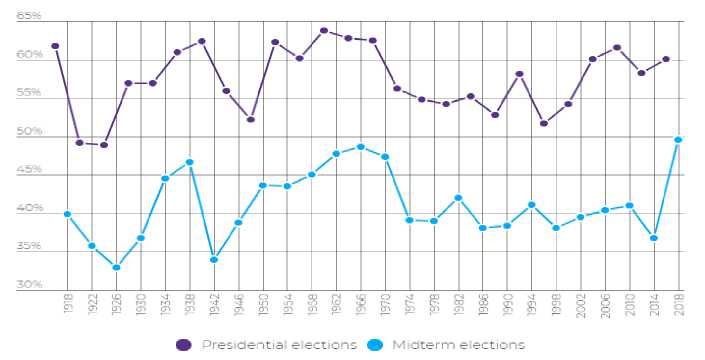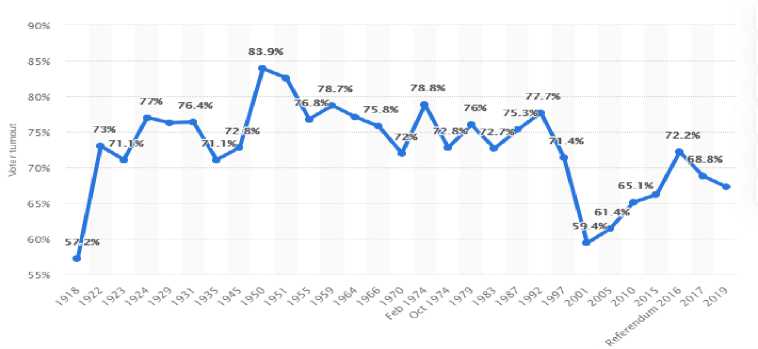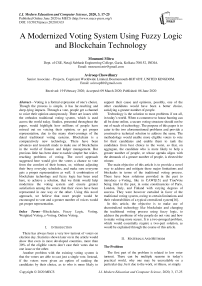A Modernized Voting System Using Fuzzy Logic and Blockchain Technology
Автор: Mousumi Mitra, Aviroop Chowdhury
Журнал: International Journal of Modern Education and Computer Science @ijmecs
Статья в выпуске: 3 vol.12, 2020 года.
Бесплатный доступ
Voting is a formal expression of one’s choice. Though the process is simple, it has far-reaching and deep-lying impacts. Through a vote, people get a channel to voice their opinion anonymously. There are issues with the orthodox traditional voting system, which is used across the world today. Studies, presented throughout the paper, would highlight how millions of people have missed out on voicing their opinion, or get proper representation, due to the many short-comings of the dated traditional voting systems. Blockchain is a comparatively new technology. There have been advances and research made to make use of blockchains in the world of finance and ledger management. But precious little has been done to tackle simpler but wider-reaching problems of voting. The novel approach suggested here would give the voters a chance to vote from the comfort of their homes, or, without adjusting their busy everyday schedules, and make sure everyone gets a proper representation as well. A combination of blockchain technology and fuzzy logic has been used here, to achieve a solution, that we think would help modernize the voting system and ensure greater satisfaction among the voters that their views have been represented in one way or the other. Using this novel approach, we believe that more people would be encouraged to vote and a greater number of voices would get proper representation.
Blockchain, Fuzzy Logic, Voting, Weighted Voting, e-Voting, Online Voting
Короткий адрес: https://sciup.org/15017588
IDR: 15017588 | DOI: 10.5815/ijmecs.2020.03.03
Текст научной статьи A Modernized Voting System Using Fuzzy Logic and Blockchain Technology
There has always been a very low turnout of voters on election day. Statistics shown later on in the article would show that even in most developed countries, more than 30% of the eligible voters don’t cast their votes due to one issue or the other.
Another problem with the existing voting system is that the voters are able to cast just a single vote. Instead, if the voters were given an option of ranking the candidates by their choice, as to who is more likely to support their cause and opinions, possibly, one of the other candidates would have been a better choice, satisfying a greater number of people.
Technology is the solution to most problems if not all, in today’s world. When e-commerce to house hunting can all be done online, a secure voting structure should not be out of reach of technology. The purpose of this paper is to cater to the two aforementioned problems and provide a constructive technical solution to address the same. The methodology would enable more eligible voters to vote for their candidates and enable them to rank the candidates from best choice to the worst, so that, on aggregate, the candidate who is more likely to help a greater number of people, or whose agenda aligns with the demands of a greater number of people, is elected the winner.
The main objective of this article is to provide a novel way to address and mitigate these major limitations and blockades in terms of the traditional voting process. There have been solutions provided in the past to introduce e-Voting, like in CAWI[15] and TrueVote being tried in the past, in some constituencies of Paris, London, Italy, and Finland with varying degrees of success. They were however curtailed in favor of the traditional voting system, owing to certain limitations and their vulnerabilities of a typical centralized system[16].
In this article, the objective is to make use of decentralized technology like blockchain and changing the traditional voting process using fuzzy logic, to address the problems of why people do not vote and how to make voting more secure. It is a two-pronged problem, which would essentially require a two-part solution, as would be explained through the course of this article.
-
II. Materials And Methods
The Problem
The first part of the problem is related to low voter turnout. There can be multiple reasons in today’s practical world, why one may be unavailable on a particular day, be it due to the work, or illness, or simply

Fig.1. US Voter turnout statistics 1918-2018
lethargy to go out and stand in a queue to cast the vote. Let’s take the UK for example. During the election day of 2019, there were innumerable reports of people having to stand in long queues for over half an hour to one hour, just to cast a simple vote. In the UK, the voting day is not declared a government holiday. So, those who even decided to turn up to vote had to miss some part of their day’s work, face the trouble of going to and from the polling station, and stand in the queue to cast their vote. In countries like India, people polling days are generally declared a government holiday, so that people can take the time out to go to the polling station and cast their vote. This leads to the government offices and businesses losing tremendous amounts of money, simply because it is an election day, which is unacceptable.
The statistics for the US elections (as shown in Figure 1, sourced from [8]) over the years, it would paint a picture that despite being one of the most advanced countries in the world, the highest voter turnout has been 64% in the last 100 years. This means, more than 1/3rd of the eligible never cast their votes per election. That count of missed votes was close to 100 million in the 2016 presidential elections. If we take the example of another such advanced country, the UK, voter turnout there has been woefully low as well (as shown in Figure 2, sourced from [9]), with the last 2019 General elections registering for just 67.3% votes. This means, close to 1/3rd of the eligible voters did not cast their votes.
Besides these, there are the obvious concerns of rigging, wrong votes, and people not being able to reach the polling station due to multiple socio-economic reasons. There is also the chance of human error when counting the ballot. There is also the obvious problem of infrastructure. To organize an election, each government has to spend huge sums of money to buy equipment, organizing polling stations, getting postal services, employing people to preside over polling stations, employing people to count the ballot, etc. According to reports, the UK General election in 2017 cost the government just over £140 million.
The second part of the problem is with people not being able to select the most suitable candidate aligning to the views and opinions of the most percentage of people. For example, say there are 3 candidates (A, B and C) in a constituency and the voter has to select just 1 of the 3 in the present-day voting system. Let’s say 40% of voters would vote for Candidate A, 25% for candidate B and 35% for candidate C. The clear measure says candidate A is the clear winner when that candidate was not the choice of 60% of the voters, leaving them disgruntled and disillusioned about the voting system.

Fig.2. UK Voter Turnout Statistics 1918-2019
Список литературы A Modernized Voting System Using Fuzzy Logic and Blockchain Technology
- Ahmed Ben Ayed. 4.2 The Blockchain In A Conceptual Secure Blockchain-based Electronic Voting System; International Journal of Network Security & Its Applications (IJNSA); Vol.9, No.3, May 2017
- Kashif Mehboob Khan; Junaid Arshad; Muhammad Mubashir Khan; Secure Digital Voting System based on Blockchain Technology; IGI Global e-Gov
- Mousumi Mitra; Atanu Das; A Fuzzy Logic Approach to Assess Web Learner’s Joint Skills; I.J. Modern Education and Computer Science, 2015, 9, pp 14-21.
- Supriya Thakur Aras; Vrushali Kulkarni; Blockchain and Its Applications – A Detailed Survey; International Journal of Computer Applications (0975 – 8887); Volume 180 – No.3, December 2017.
- Marc Pilkington; Blockchain Technology: Principles and Applications.
- Nir Kshetri; Jeffrey Voas; Blockchain-Enabled E-voting; IEEE Software 35(4), 95-99.
- Ølnes, S. and Jansen, A. 2017. Blockchain Technology as Support Infrastructure in e-Government. Springer, Cham; IFIP International Federation for Information Processing 2017; EGOV 2017, LNCS 10428, pp. 215–227.
- Voter Turnout - FairVote. Available online: https://www.fairvote.org/voter_turnout#voter_turnout_101 (accessed on 01 January 2020).
- Voter turnout in general elections and in the Brexit referendum in the United Kingdom from 1918 to 2019. Available online: https://www.statista.com/statistics/1050929/voter-turnout-in-the-uk/ (accessed on 01 January 2020)
- Analysis of the contesting candidates in General Election 2019. Available online: http://prsindia.org/theprsblog/analysis-contesting-candidates-general-election-2019 (accessed on 03 January 2020)
- P. Boucher, What If Blockchain Technology Revolutionised Voting?, European Parliamentary Research Service, 2016; http://www.europarl.europa.eu/thinktank/en/document.html?reference5EPRS_ATA(2016)581918
- “Not-So-Clever Contracts,” Economist, 28 July 2016; https://www.economist.com/news/business/21702758-time-being-least-human-judgment-still-better-bet-cold-hearted
- Iuon-Chang Lin and Tzu-Chun Liao 2017. A Survey of Blockchain Security Issues and Challenges; International Journal of Network Security, Vol.19, No.5, PP.653-659, Sept. 2017
- Archana Prashanth Joshi, Meng Han, and Yan Wang. A survey on security and privacy issues of blockchain technology; American Institute of Mathematical Sciences, May 2018, Volume 1, Issue 2; PP.121-147
- Alvarez, R.M. and J. Nagler (2000) The likely consequences of Internet voting for political representation. Loyola of Los Angeles Law Review, Vol 34, No. 3.
- Anne-Marie Oostveen and Peter van den Besselaar. Users’ experiences with e-voting: A comparative case study; International Journal of Electronic Governance; January-2009; DOI: 10.1504/IJEG.2009.030527


